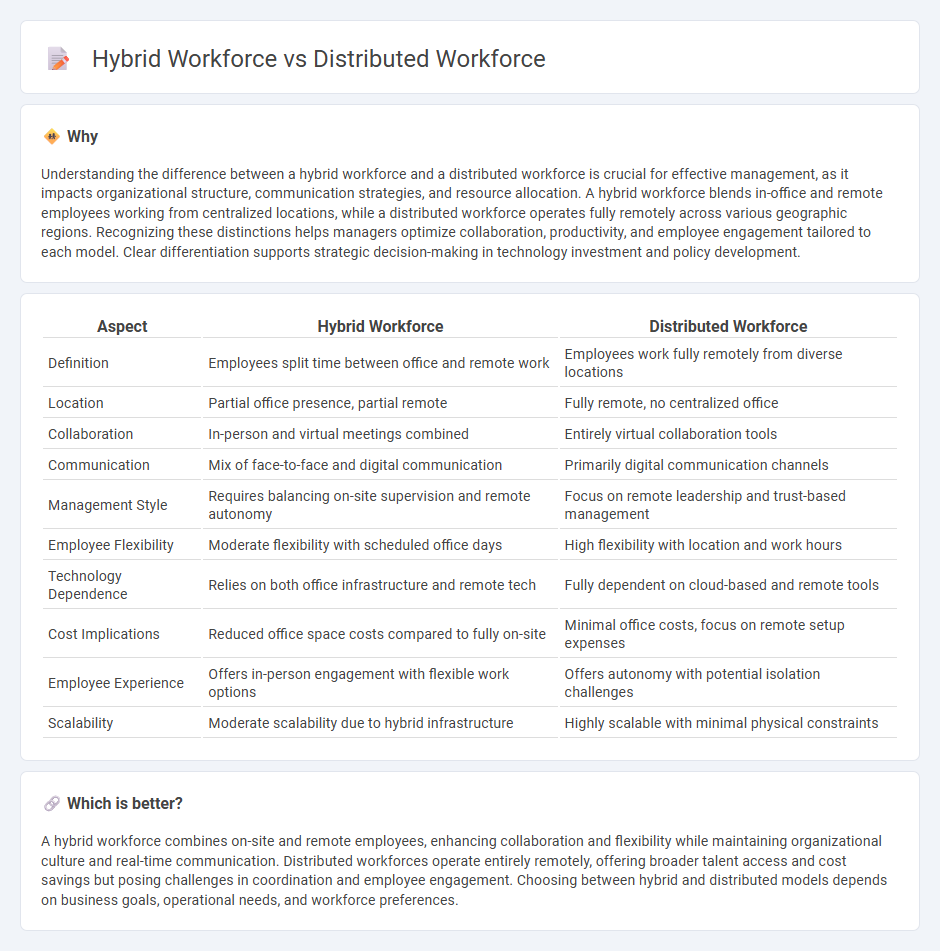
Hybrid workforce models combine in-office and remote work, enabling flexible schedules and enhanced collaboration while maintaining physical presence intermittently. Distributed workforce structures operate entirely remotely, leveraging digital tools to connect employees across diverse geographical locations for continuous productivity and global talent access. Explore how organizations optimize performance and culture by choosing between hybrid and distributed workforce strategies.
Why it is important
Understanding the difference between a hybrid workforce and a distributed workforce is crucial for effective management, as it impacts organizational structure, communication strategies, and resource allocation. A hybrid workforce blends in-office and remote employees working from centralized locations, while a distributed workforce operates fully remotely across various geographic regions. Recognizing these distinctions helps managers optimize collaboration, productivity, and employee engagement tailored to each model. Clear differentiation supports strategic decision-making in technology investment and policy development.
Comparison Table
| Aspect | Hybrid Workforce | Distributed Workforce |
|---|---|---|
| Definition | Employees split time between office and remote work | Employees work fully remotely from diverse locations |
| Location | Partial office presence, partial remote | Fully remote, no centralized office |
| Collaboration | In-person and virtual meetings combined | Entirely virtual collaboration tools |
| Communication | Mix of face-to-face and digital communication | Primarily digital communication channels |
| Management Style | Requires balancing on-site supervision and remote autonomy | Focus on remote leadership and trust-based management |
| Employee Flexibility | Moderate flexibility with scheduled office days | High flexibility with location and work hours |
| Technology Dependence | Relies on both office infrastructure and remote tech | Fully dependent on cloud-based and remote tools |
| Cost Implications | Reduced office space costs compared to fully on-site | Minimal office costs, focus on remote setup expenses |
| Employee Experience | Offers in-person engagement with flexible work options | Offers autonomy with potential isolation challenges |
| Scalability | Moderate scalability due to hybrid infrastructure | Highly scalable with minimal physical constraints |
Which is better?
A hybrid workforce combines on-site and remote employees, enhancing collaboration and flexibility while maintaining organizational culture and real-time communication. Distributed workforces operate entirely remotely, offering broader talent access and cost savings but posing challenges in coordination and employee engagement. Choosing between hybrid and distributed models depends on business goals, operational needs, and workforce preferences.
Connection
Hybrid workforce models blend onsite and remote work, while distributed workforce structures operate entirely from multiple locations. Both approaches rely heavily on digital collaboration tools and cloud-based platforms to maintain productivity and communication. Effective management of these workforces requires robust strategies for coordinating tasks, monitoring performance, and fostering team engagement across diverse environments.
Key Terms
Remote Work
Distributed workforce operates entirely remotely with employees working from diverse geographical locations without a central office, while a hybrid workforce combines remote and on-site work, offering flexibility by allowing employees to split their time between home and office. Remote work in a distributed model demands robust digital communication tools and self-management skills, whereas hybrid work often balances in-person collaboration with virtual interactions for increased team cohesion. Explore more about optimizing remote work strategies for both workforce models to enhance productivity and employee satisfaction.
Flexible Scheduling
Distributed workforce offers unparalleled flexible scheduling by enabling employees to work from various locations and time zones, thus promoting productivity across global teams. Hybrid workforce combines in-office and remote work, allowing flexible hours but often requires syncing schedules for in-person collaboration. Discover how flexible scheduling shapes efficiency in both distributed and hybrid workforce models.
Office Presence
A distributed workforce operates with employees working remotely across various locations, minimizing the need for office presence and promoting flexibility. In contrast, a hybrid workforce blends remote and in-office work, requiring strategic scheduling to balance office presence and team collaboration. Explore the benefits and challenges of each model to optimize your organization's work environment.
Source and External Links
Distributed Workforce - HeyTaco - A distributed workforce consists of employees working from multiple geographic locations, relying on digital tools to collaborate remotely, which offers benefits like access to global talent, increased productivity, and lower operational costs.
10 Tips on How to Effectively Engage a Diverse, Distributed Workforce - Cerkl - This workforce model allows employees flexibility to work from various locations worldwide, enhancing productivity and employee engagement while reducing costs and supporting work-life balance.
What is a Distributed Workforce and How to Manage it? - LumApps - It describes employees in multiple locations including homes and satellite offices, with significant advantages in flexibility and performance, especially in sectors suited for remote work like IT and finance.
 dowidth.com
dowidth.com